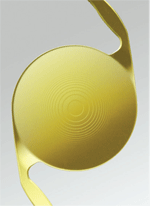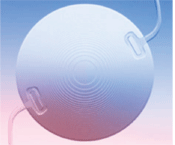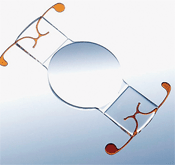Consistent innovations in multifocal and accommodating intraocular lenses are revolutionizing how eye care providers effectively combat presbyopia. Since the mid 1980s, dozens of FDA trials have examined the efficacy and safety of presbyopia-correcting IOLs. But, many early lenses demonstrated only moderate patient satisfaction. Today’s advanced and extensively tested technologies, on the other hand, are yielding outstanding postoperative outcomes. And, as we know, there is always room for improvement.
Multifocal IOLs

The AcrySof ReSTOR Multifocal IOL (Alcon).
Multifocal IOLs attempt to replace a patient’s natural accommodation with multiple fixed images. Today, there are three primary multifocal IOL options in the United States: ReZoom (Abbott Medical Optics), AcrySof ReSTOR (Alcon) and Tecnis (Abbott Medical Optics).
Multifocal lenses are classified as either as zonal refractive or diffractive. Zonal refractive multifocal IOLs, such as ReZoom, create several simultaneous images. They allow a patient to view an object at all distances. However, this ability can cause the patient to experience a variety of undesirable visual aberrations, including night glare, halo and starburst.1
Aspheric, diffractive IOLs, such as AcrySof ReSTOR and Tecnis, effectively compensate for spherical aberration and improve visual quality in most patients.2 Diffractive lenses generate two distinct images—one for distance and one for near. However, because of this feature, diffractive multifocal IOLs often yield less-than-ideal intermediate vision.3
Other points about the three currently available multifocal IOL options:
• ReZoom. ReZoom received FDA approval in March 2005. It is a second-generation, refractive multifocal lens that distributes light across five optical zones. These zones are varied proportionally to provide optimal vision under different lighting conditions.4 Some zones have been designed to offer clearer low light/distance vision and to reduce haloes and glare during nighttime driving.
• AcrySof ReSTOR. The AcrySof ReSTOR 4.0 was the first FDA-approved diffractive multifocal IOL. Its design is based on the optical principle of apodization—a series of graduated steps that result in diffraction of light at both distance and near. The ReSTOR 4.0 includes a 4.00D add, which yields a 3.20D add at the spectacle plane. A recent update to the ReSTOR, version 3.0, includes a 3.00D add that yields 2.50D at the spectacle plane and is intended to enhance intermediate vision.5
• Tecnis. FDA-approved in January 2009, Tecnis is the newest diffractive multifocal IOL available in the United States. The lens features a prolate anterior surface with 0.27µm of negative spherical aberration and a posterior surface with diffractive rings that provide near and distance images.6 Additionally, the Tecnis Multifocal IOL is composed of an acrylic material with chromatic aberration correction, which helps optimize the focus of normal white light for both distance and near vision.7
Accommodating IOLs

The Tecnis Multifocal IOL (Abbott Medical Optics).
Accommodating IOLs attempt to simulate the patient’s natural accommodation process by changing power in response to ocular muscle contraction. Currently, the Crystalens HD (Bausch & Lomb) is the only FDA-approved accommodating IOL. Accommodating IOLs attempt to more closely simulate a patient’s natural vision than a multifocal IOL. Additionally, they often provide better distance vision than multifocal IOLs. And, of greatest importance, most patients with accommodating IOLs report significantly fewer visual aberrations than patients implanted with multifocal IOLs.8
However, accommodating IOLs have one prominent disadvantage vs. multifocal IOLs: They often yield unsatisfactory near vision. In fact, many patients who elect for accommodating IOL implantation still require reading glasses to supplement near vision.9
• Crystalens HD. The Crystalens HD is a plate haptic IOL with a small add on the front of the lens as well as an aspheric back surface to facilitate improved visual quality.9 The Crystalens HD’s additional frontal add power improves a patient’s near vision more than
previous versions.6
Crystalens HD’s haptic acts as “hinge” that allows the lens to move forward and flex secondary to vitreous pressure during accommodation. The optic of the lens moves forward in accordance with ciliary muscle contraction, providing a more “natural” accommodative effect than most multifocal IOLs.10
Presbyopia-Correcting IOLs in the Pipeline

The Crystalens HD Accommodating IOL (Bausch & Lomb).
• The At Lisa Toric Multifocal IOL. The At Lisa Toric (Carl Zeiss Meditec) is the first model of an aspheric, toric, diffractive bifocal IOL that corrects combined refractive errors.11 The lens integrates functional multifocal correction and postoperative astigmatism correction into one technology. Currently, the At Lisa Toric is only available in Europe.
• Synchrony Dual-Optic Accommodating IOL. Synchrony (Visiogen, Inc.) will likely be the next accommodating IOL to gain FDA approval. Its dual-optic system includes one anterior optic with a high plus power and one posterior optic with a high negative power.12 When the ciliary body is relaxed, the optics remain close together for distance vision. When the ciliary body contracts, the optics move apart, which increases lens power and provides optimum near acuity.12
• Tetraflex Accommodating IOL. Tetraflex (Lenstec, Inc) has two haptics and moves anteriorly secondary to vitreous pressure. This action, in turn, enhances near acuity.13 All patients in the FDA phase 3 trial have completed one year of follow-up, and Lenstec plans to submit for premarket approval in the fourth quarter of 2009.7
• The Light Adjustable Lens. The Light Adjustable Lens (Calhoun Vision) is a cutting-edge adjustable IOL designed specifically to lessen the potential for unsatisfactory refractive outcomes following implantation. The Light Adjustable Lens is comprised of a photosensitive silicone material that can be postoperatively reshaped with ultraviolet light to correct any residual refractive error.14 The Light Adjustable Lens is available in Europe and is currently in FDA phase 2 clinical trials.7
1. Lubinski W, Gronkowska J, Barnyk K, et al. Visual function and c omplications after cataract surgery with bilateral multifocal intraocular lens implantation. Klin Oczna. 2007;109(7-9):261-6.
2. Gierek-Ciaciura S, Cwalina L, Bednarski L, Mrukwa-Kominek E. A comparative clinical study of the visual results between three types of multifocal lenses. Graefes Arch Clin Exp Ophthalmol. 2009 Sep 8. [Epub ahead of print]
3. Barisić A, Dekaris I, Gabrić N, et al. Comparison of diffractive and refractive multifocal intraocular lenses in presbyopia treatment. Coll Antropol. 2008 Oct;32 Suppl 2:27-31.
4. Forte R, Ursoleo P. The ReZoom multifocal intraocular lens: 2-year follow-up. Eur J Ophthalmol. 2009 May-Jun;19(3):380-3.
5. Alcon Labs. AcrySof IQ ReSTOR SN6AD1 package insert. Fort Worth, Texas.
6. Owen J. A patient-centric view of premium IOLs. Rev Optom. 2009 Oct;146(10):74-83.
7. Maloney RK. Future IOLs. Cataract and Refract Surg Today. 2009 Sep:80-2.
8. Doane JF. Accommodating intraocular lenses. Curr Opin Ophthalmol. 2004 Feb;15(1):16-21.
9. Jedlicka J. The nuances of premium IOL comanagement. Rev Cornea Contact Lens. 2009 Sep;146(6):17-22.
10. Waltz K. Paper presented at the American Society for Cataract and Refractive Surgeons (ASCRS) meeting. Chicago, 2008.
11. Liekfeld A, Torun N, Friederici L. A new toric diffractive multifocal lens for refractive surgery. Ophthalmologe. 2009 Sep 30. [Epub ahead of print]
12. McLeod SD, Vargas LG, Portney V, Ting A. Synchrony dual-optic accommodating intraocular lens. Part 1: optical and biomechanical principles and design considerations. J Cataract Refract Surg. 2007 Jan;33(1):37-46.
13. Brown D. Functional reading acuity and performance: comparison of 2 accommodating intraocular lenses. J Cataract Refract Surg. 2009 Oct;35(10):1711-4.
14. Chayet A, Sandstedt C, Chang S, et al. Correction of myopia after cataract surgery with a light-adjustable lens. Ophthalmology. 2009 Aug;116(8):1432-5.

